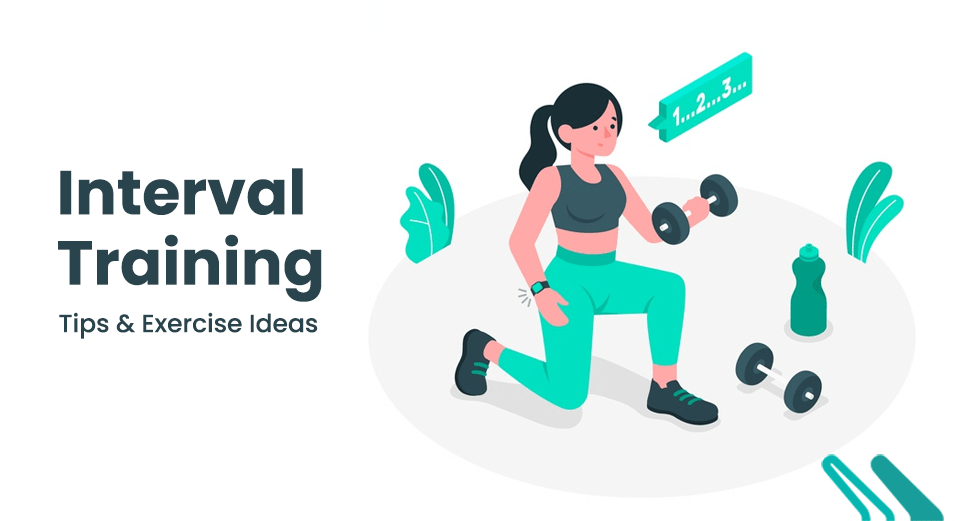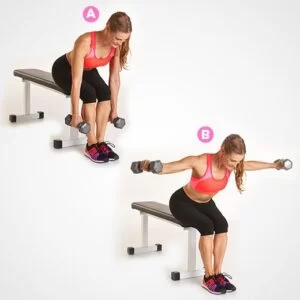Interval Training
Interval training is most typically used combined with traditional cardiovascular exercises such as running, rowing, cycling, and swimming to push yourself harder than you could in a continuous effort.
It consists of a succession of small bursts of activity (work intervals) that can last anywhere from a few seconds and several minutes. During each interval, you labor at a specific intensity for a particular amount of time or distance, followed by a low-intensity rest phase. To achieve different goals from your training session, you may modify the speed, duration, and rest period.
It’s simple to create your interval training programs. The knowledge in this article, combined with the examples below and a little imagination, can assist you in putting together the ideal interval training routine.
What is Interval Training?
- Interval training is an example of a training activity that consists of a sequence of high-intensity workouts followed by rest or break times. The high-intensity intervals are often close to anaerobic exercise, whereas the recovery periods comprise lower-intensity activity.
- Interval training is good for both aerobic (with oxygen) and anaerobic (without oxygen) energy systems, and it is especially effective in increasing VO2 Max and anaerobic thresholds. In practice, this means you’ll be able to work harder (run faster) and maintain that intensity for longer periods (go further and faster).
- Interval training may be used to improve endurance performance or recovery rate in team sports such as football or rugby, which need repeated bursts of high-intensity exercise, depending on your goals.
How Interval Training Works?
Interval exercise stimulates both aerobic and anaerobic systems. During high-intensity activities, the anaerobic system utilizes energy stored in the muscles (glycogen) for brief bursts of activity. Anaerobic metabolism operates without oxygen, yet the byproduct is lactic acid.
As lactic acid accumulates, the athlete enters an oxygen deficit, and during the recovery phase, the heart and lungs collaborate to pay back this oxygen debt and break down the lactic acid. During this phase, the aerobic system utilizes oxygen to transform stored carbohydrates into energy.
It is considered that practicing high-intensity intervals that build lactic acid during practice helps the body adapt and burn lactic acid more efficiently during exercise. This implies that athletes may exercise at a higher intensity for longer before becoming fatigued or experiencing pain.
Interval training engages the aerobic and anaerobic systems repeatedly during high-intensity exercise.
- The anaerobic system converts energy stored in the muscles (glycogen) into brief periods of action that do not require oxygen.
- Lactic acid accumulates as a byproduct, and the athlete feels a shortage of oxygen.
- The body is then allowed to recuperate, with the heart and lungs working together to replenish the oxygen and break down the lactic acid.
- The aerobic system takes control, utilizing oxygen to transform stored carbs into energy.
Basic Types of Interval Training
While there are infinite methods to build an interval training program, they can all be classified into two categories.
Fitness Interval Training
- This approach is suitable for both beginners and intermediate exercisers.
- This training strategy employs intervals of higher intensity (60% – 85% heart rate reserve) that typically last 2-5 minutes, followed by periods of decreased intensity of the same length.
Performance Interval Training
- This is a more advanced approach that is best suited to well-conditioned athletes.
- This training strategy employs intervals of maximal effort (85% – 100% heart rate reserve) that typically last 2-15 minutes, followed by reduced intensity periods of the same or shorter length.
Common Examples of the Interval Training
The exercises in the list below show how simply interval training programs may be adapted to most sports or activities. Variations in the intensity and duration of work intervals, as well as the length of rest periods, can induce specific training responses.
- Jumping(Skipping) Rope: Skipping rope is a cheap and quick way to improve overall fitness. It can improve physical strength, endurance, balance, agility, and calorie burn while also increasing cardiovascular fitness.
- Sprinting for 30-second drills: Sprinting for 30-second drills improves aerobic capacity and fitness in just a little of the time required for prolonged, slow training. For example, you might run at a steady pace for 20-30 minutes (depending on your abilities), or you may go all out and reach your heart’s maximum capacity in seconds.
- Sprint and Speed Workout: Sprint and Speed Workout exercises are effective in all sports because they mix speed and endurance. Start only after three months of consistent athletic activity and reaching a fitness level that allows you to run for 20-30 minutes at a time.
- Explosive Exercise Training Routines: are another method for increasing power and strength. Professional athletes use it in sports that require brief bursts of high effort, including sprinting and leaping.
- Agility drills: Agility drills help players enhance their coordination, speed, power, and sports abilities. These activities also assist in improving foot speed and athletic skill.
- Shuttle Runs: Shuttle runs are common agility and speed workouts for athletes participating in stop-and-start sports such as basketball, soccer, hockey, and tennis.
- Stair Running: Stair Running is an advanced workout that improves speed, power, and cardiovascular fitness. A terrific complement to any agility training program because of its rapidity, foot speed, and outstanding sprint workout.
- Plyometric Jumping Exercises: Many athletes and trainers employ plyometric jumping exercises to improve athletic power (both strength and speed), coordination, and agility for better sports performance.
- Tuck Jumps: Tuck Jumps are basic routines that improve agility and dynamic power, allowing athletes to increase their vertical leap. Used to improve vertical, high, box, and long jump performance.
How to Create an Interval Training Program?
Warm up before doing any of the routines listed below, and be sure to observe the warnings and safety rules outlined in the section below.
Here is an example of the Interval Training Program:
Sprint Program:
- Use this program 2-3 times per week, with ample recuperation between exercises.
- First sprint at 60 percent maximal effort for roughly 200m (modify distance based on fitness level and experience).
- Recover for two minutes by slowing down to an easy jog or walk.
- Second sprint at around 80% of maximal effort.
- Recover for two minutes by slowing down to an easy jog or walk.
- The rest of your sprints should be completed with all-out effort.
- Following each remaining sprint, allow 2 to 4 minutes for recovery.
- Begin with four sprint/recovery workouts and gradually increase to eight, depending on your fitness level.
- Allow for 1-2 days of recovery in between sprint exercises.
The Shuttle Run
- The Shuttle Run applies to sports including football, hockey, basketball, and tennis.
- Set marks 25 yards apart. Sprint from one marker to the next and return for one repetition.
- Perform six repetitions at maximum speed and time your results.
- Rest for 5 minutes, making sure you keep moving.
- Repeat the drill once more.
- To get the average time, add the two times and then half them.
- Monthly tests will help you track your development.
- Allow for 1-2 days of resting in between sprint exercises.
Best Exercises Used in Interval Training
- The benefits of incorporating interval training into your workout program include increased strength and endurance. You may create a 20- to 30-minute plan that combines these excellent interval workout alternatives.
- Begin with a 5-minute warm-up before moving on to short, high-intensity intervals. Each period can last anything from 30 seconds to 2 minutes, with a minute of easy walking between reps. Exercise for around 20 minutes, then cool down.
- Jump rope, stair running, burpees, shuttle sprints, spinning, dumbbell squat to press, pull-ups, push-ups, weighted walking lunges, and v-sits are all interval workouts with instructions and benefits shown below.

Jumping Rope
- With a jump rope, you can easily and affordably incorporate high-intensity interval training into your workout program.
- When done correctly, jumping rope can enhance cardiovascular fitness, balance, agility, and strength.
- Do single leaps for a minute or two to feel the heat and burn some calories.
Burpees
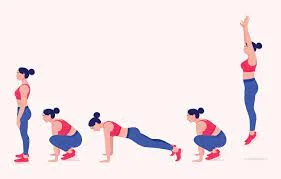
- Burpees are gaining popularity again. This simple yet effective workout targets your entire body, particularly your cardiovascular system.
- Begin by standing tall, then kneel with your hands on the floor in front of you. Then kick your feet back into a push-up stance.
- If you want a challenging workout, do a push-up while you’re here. You may also simply hop your feet back to the starting position, leap high into the air, and repeat.

Stair Running
- Running stairs is a great interval workout that takes little time and requires no special equipment.
- The cardiovascular advantages are comparable to jogging.
- Stairs are an excellent strategy to increase sprint power.
Shuttle sprints
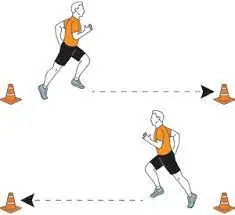
- Shuttle sprints are a common agility and speed workout performed by athletes in stop-and-go sports including soccer, hockey, basketball, and tennis.
- To execute shuttle sprints, place two markers approximately twenty-five feet apart. Sprint from one marker to the next and back is one repeat.
- Try 10 sprints at a time. Shuttle sprints can be done forward, backward, or sideways.
Spinning

- If you join a spin class, you will most likely be doing some high-intensity spin intervals. However, you may design your interval exercise using your home trainer or by attending a spin class during the off hours.
- Combine cycling with other bodyweight exercises for a quick workout.
- One of the most popular kinds of indoor exercise is riding a stationary or spinning cycle, which delivers a low-impact, high-intensity cardiovascular workout while also building muscle and endurance.
Dumbbell squat to press
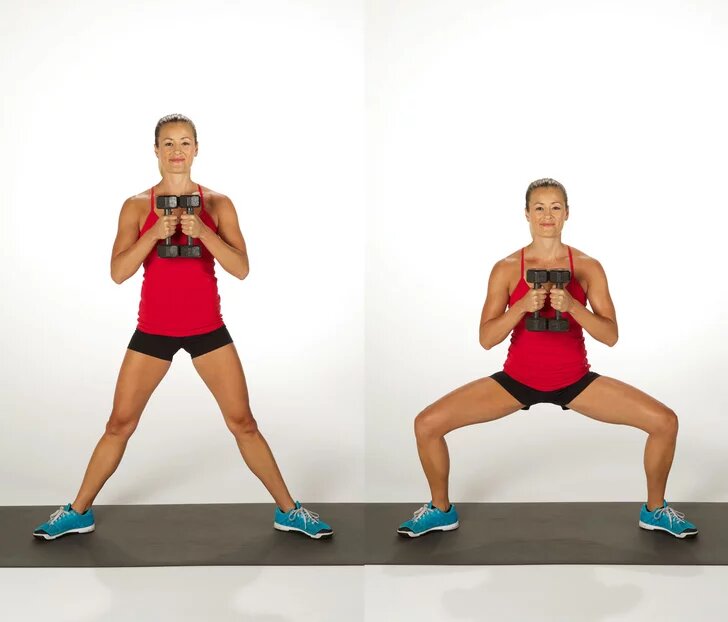
- Weights are a simple method to increase the intensity of an activity.
- Combine a dumbbell squat and an overhead press for a total-body exercise that works your arms and shoulders, core, quadriceps, and glutes.
- Assume the position of a chair by bending your knees and lowering your hips. Maintain a straight back, an elevated chest, and a strong core. To keep your balance, press your heels into the ground. Go down until your thighs are about in line with the floor.
- Extend your arms fully and push the dumbbells overhead with an explosive motion as soon as you reach the bottom of the squat. Keep your elbows tight to your sides and tense your shoulders throughout the exercise.
- Controllably raise yourself out of the squat by lowering the dumbbells back down to shoulder height. Throughout the exercise, keep your posture straight and your core active.
Push-ups
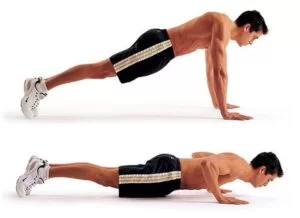
- Standard push-ups are a simple, equipment-free total-body workout that strengthens the upper body and core.
- This complex exercise, when performed slowly, works muscles in the chest, shoulders, triceps, back, abs, and hips.
- With your hands shoulder-width apart and your fingers pointed forward, begin in the high plank posture. From head to toe, your body should make a straight line.
- With your elbows bent at a 45-degree angle, contract your core and bring your chest down to the floor. Maintain your elbows close to your body.
- When you reach the bottom of the action, pause and bring your chest nearly to the floor.
- As you stretch your arms and push yourself back up to the starting position, release your breath.
Pull-ups

- Pull-ups take some basic equipment or inventiveness (go to a playground or find a solid low-hanging tree limb, for example), but they are an excellent, straightforward technique to increase upper body strength.
- Stand under a pull-up bar with your hands shoulder-width apart and palms facing away (overhand grip).
Jump up and grasp the bar. Your arms should be straight, and your body should be suspended in a dead hang. - Engage your core and lift yourself until your chin is above the bar. Keep your elbows close to your body while pulling. Return to your starting posture by lowering yourself gradually.
Walking Lunge with Weights
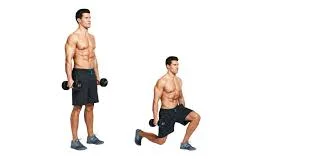
- Walking lunges will help you gain endurance, strength, and balance. This workout offers several advantages for practically all types of athletes.
- If holding a weight above during a walking lunge seems unnatural, start with bamboo or an empty barbell until you become used to the exercise.
- Step forward forcefully, landing heel first, using one leg. To get into a lunge position as soon as you land, bend both knees. Your rear knee should be floating just above the ground, and your front knee should be exactly below your ankle (without touching).
- When lowering, maintain an engaged torso and an upright upper body. To fully stand up, push through your front heel and extend your front leg. In unison, extend your rear leg beneath you, take a big stride forward, and repeat the lunge on the opposite side.
- Continue at a steady pace, lunging forward repeatedly and switching legs with every step. Throughout the exercise, pay close attention to your form and posture.

V-Sit Abdominal Exercise
- Finish your practice with a minute or two of ab exercises and call it a day.
- The v-sit is a challenging core exercise that works the rectus abdominis and external and internal obliques. The hip flexors are also worked during this workout.
- Reach your arms towards your shins or feet while keeping your upper body and legs off the ground by using your core. Maintain a straight back and long legs.
- After maintaining the V-shape for a little moment, carefully reposition your legs and back to the beginning position.
Benefits of Interval Training
- Enhanced endurance- Interval training trains your heart to pump more blood to your muscles and your muscles to extract oxygen more effectively, making all of your other exercises easier.
- Exercises that are more efficient and speedier – Interval training are excellent time saver if you do not have much time. They allow you to do a lot in a short amount of time. This is the sort of workout you should do if you want to get in and out of the gym fast. The entire session may be done in as few as 15-20 minutes.
- Injury and overtraining risks are minimized – By varying the level of activity during your workout, you may be able to avoid injuries or overtraining.
- Weight loss – Research shows that interval training, even at a modest intensity, can burn more fat and continue to burn calories after the workout is completed.
- The Pleasure Factor – Interval exercises are less repetitive and boring than other workouts because they offer more variation.
What Makes This Type of Training so Effective?
- Interval training may be used at all levels of fitness training, including beginners, intermediate exercisers, and well-conditioned athletes.
- Interval training allows for more intense exercise without causing excessive weariness. Intense repetition causes the athlete’s body to react by adjusting to the new procedure. This leads to various benefits:
- New capillaries are formed, delivering oxygen to the muscles and strengthening them, including the heart muscle.
- The combination of a stronger cardiovascular system and muscles that can tolerate lactic acid buildup considerably increases sports performance and well-being.
- Long-term, repeated exercise-related injuries are greatly minimized due to a lack of overtraining or burnout. Overall, aerobic power and fitness levels have increased.
- Useful for attempting a new sort of exercise or activity. Allows you to gradually progress to continuous exercise in a far more fun and effective manner, without tiring too soon.
Precautions and Safety Guidelines of the Interval Training:
Interval training is an excellent kind of exercise; however, the most common issue with interval training is that people become overly excited due to the intensity of the exercises and push themselves harder than they would normally do. This typically leads to aching muscles and joints, overtraining, and an increased risk of injury. Here are a few measures to consider.
- Set a reasonable training objective that fits your current fitness level.
- Before starting your intervals, perform a safe warm-up exercise.
- Begin slowly and progress to longer intervals for greater outcomes.
- Maintain a consistent yet difficult speed throughout the interval.
- Increase the number of repetitions with time.
- During the rest interval, keep your heart rate between 100 and 110 beats per minute.
- To improve your fitness, raise either the intensity or the time, but not both.
- Extend any increases gradually over time.
- Train on smooth, level surfaces.
- Also, don’t forget to integrate regular stretching and flexibility training into your exercise routine. The increased intensity of interval training necessitates that your muscles and joints remain flexible and elastic.
FAQs
What is Interval Training?
Interval training is a sort of training activity that consists of a sequence of high-intensity workouts followed by rest or break times. The high-intensity intervals are often close to anaerobic exercise, whereas the recovery periods comprise lower-intensity activity.
What is the aim of interval training?
Interval training can help improve both aerobic (with oxygen) and anaerobic (without oxygen) energy systems. It is quite effective in increasing your VO2 Max and anaerobic threshold. This implies you’ll be able to work harder and stay at the same level for longer periods.
Is 30 minutes of interval training sufficient?
30 minutes is plenty of time to engage all of the major muscle groups with a circuit of low weights and high repetitions. This sort of high-intensity interval training (HIIT) burns a lot of calories and fat while also increasing muscular strength and endurance.
Is interval training effective for fat loss?
High-intensity interval training (HIIT) can help people lose weight by burning more calories, lowering body fat, and increasing overall health. HIIT can provide similar advantages to other forms of rigorous workouts and activities.
What are the five benefits of interval training?
10 advantages of high-intensity interval training (HIIT).
It increases your stamina.
It improves your strength.
You will burn a lot of fat during your workout.
Your body will burn fat following your workout.
It maintains your heart healthy.
It keeps you youthful.
It is quick and so reduces stress.
It can help strengthen your bones.
References
- Walker, B. (2023, February 15). Interval training. StretchCoach.com | Stretching and Flexibility. https://stretchcoach.com/articles/interval-training/
- Ms, E. Q. (2022b, October 16). Interval training workouts build speed and endurance. Verywell Fit. https://www.verywellfit.com/interval-training-workouts-3120774
- Stephens, K. (2023, March 7). What is interval training? | Kinetik wellbeing. Kinetik Wellbeing. https://www.kinetikwellbeing.com/what-is-interval-training/
- Ms, E. Q. (2022, September 30). 10 best interval training exercises. Verywell Fit. https://www.verywellfit.com/best-interval-training-exercises-3120602

